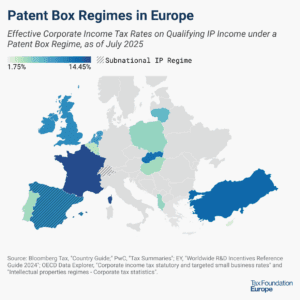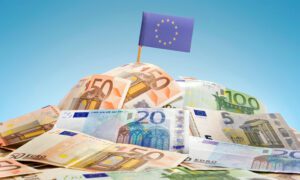
Reducing Germany’s Corporate Tax Rate to 25 Percent
6 min readBy:Ahead of Germany’s federal election, the country’s economy remains stuck in a prolonged recessionA recession is a significant and sustained decline in the economy. Typically, a recession lasts longer than six months, but recovery from a recession can take a few years. , with GDP stagnating for the past two years and failing to surpass its pre-pandemic level. Increased borrowing costs, constrained energy supplies, and trade disruptions driven by international conflicts have all contributed to this economic malaise. These challenges are hitting Germany’s capital- and energy-intensive export industries particularly hard, as well as capital-heavy sectors like construction.
In this context, taxA tax is a mandatory payment or charge collected by local, state, and national governments from individuals or businesses to cover the costs of general government services, goods, and activities. policy could play a crucial role in removing barriers to growth. Cutting Germany’s high corporate tax rate can stimulate investment by lowering the cost of capital and reducing inefficiencies in asset allocation and financing. This could raise GDP by 1 percent, investment by 1.4 percent, and wages by 0.8 percent in the long run, relative to keeping the 30 percent rate. However, the corporate tax rate is only one tax policy variable that affects investment decisions. Policymakers should look at other options to reduce the corporate tax burden on investment.
Cutting Germany’s Corporate Tax Rate to 25 Percent
Corporate income taxes tend to be the most harmful to economic growth among major types of taxes, because they increase the cost of new investment. In the long run, more than half of the corporate tax burden is borne by workers, as lower investment in the capital stock reduces their productivity and wages.
Currently, Germany levies one of the highest combined corporate tax rates in the Organisation for Economic Co-operation and Development (OECD), significantly exceeded only by Portugal (30.5 percent) and Colombia (35 percent). Both the Christian Democratic Union and the Free Democratic Party have proposed reducing Germany’s combined corporate tax rate from approximately 30 percent to below 25 percent, bringing it closer to the OECD average of 23.85 percent.
The next German government will have several policy levers to lower its corporate rate to 25 percent. The federal rate is a uniform 15 percent, plus a 5.5 percent solidarity surtaxA surtax is an additional tax levied on top of an already existing business or individual tax and can have a flat or progressive rate structure. Surtaxes are typically enacted to fund a specific program or initiative, whereas revenue from broader-based taxes, like the individual income tax, typically cover a multitude of programs and services. , while the other half of the combined corporate rate depends on local business taxes.
Evidence suggests that the local business tax is more harmful to investment relative to the revenues it generates, but eliminating it would require negotiations to restructure local government funding. This may make it politically easier to cut the federal rate from 15 to 10 percent and potentially abolish the solidarity surtax on corporate income taxA corporate income tax (CIT) is levied by federal and state governments on business profits. Many companies are not subject to the CIT because they are taxed as pass-through businesses, with income reportable under the individual income tax. liability.
Macroeconomic Effects of Corporate Rate Cut
Tax Foundation Europe model simulations based on the 2022 German economy estimate the economic gains and budget costs from moving to a 25 percent combined corporate rate and find that the change would boost Germany’s investment by 1.4 percent, GDP by 1 percent, and wages by 0.8 percent.
Macroeconomic Effects of Reducing Germany’s Corporate Rate to 25 Percent
| Service Price of Capital | GDP | Investment | Wages | |
|---|---|---|---|---|
| Corporate Rate from 30% to 25% | -1.6% | +1.0% | +1.4% | +0.8% |
This is mostly driven by lowering effective marginal tax rates (EMTRs) on investments across the board. A lower corporate tax rate would also reduce various distortions arising from uneven tax treatment of different types of investments, income profiles over time, and financing methods. These distortions lead companies to prioritize tax-advantaged investments and business models, even when they generate lower pre-tax returns.
For example, depreciationDepreciation is a measurement of the “useful life” of a business asset, such as machinery or a factory, to determine the multiyear period over which the cost of that asset can be deducted from taxable income. Instead of allowing businesses to deduct the cost of investments immediately (i.e., full expensing), depreciation requires deductions to be taken over time, reducing their value and discouraging investment. schedules require businesses to deduct investment costs over multiple years, typically reflecting an asset’s expected lifespan. However, this delayed deduction reduces the real value of cost recoveryCost recovery refers to how the tax system permits businesses to recover the cost of investments through depreciation or amortization. Depreciation and amortization deductions affect taxable income, effective tax rates, and investment decisions. as inflationInflation is when the general price of goods and services increases across the economy, reducing the purchasing power of a currency and the value of certain assets. The same paycheck covers less goods, services, and bills. It is sometimes referred to as a “hidden tax,” as it leaves taxpayers less well-off due to higher costs and “bracket creep,” while increasing the government’s spending power. and the time value of money erode its worth. The longer the depreciation schedule, the smaller the share of investment costs businesses can recover, discouraging capital investment.
Businesses are also able to deduct interest payments on debt but not dividend distributions to shareholders, making debt financing relatively more attractive. A lower corporate tax rate would shrink this distortion, reducing the economy’s vulnerability to systemic shocks.
Revenue Impacts of Moving to a 25 Percent Corporate Rate
In the short term, cutting Germany’s corporate tax rate to 25 percent would reduce federal revenue by €15.4 billion. Over time, increased investment and higher business incomes in response to the lower rate would partially offset the loss, bringing the corporate revenue reduction to €14.7 billion.
However, corporate taxes make up only 6.2 percent of Germany’s total tax revenue in 2022. The overall impact depends on other sources, such as personal income taxes, social contributions, and value-added tax (VAT). If the federal government keeps income tax and social contribution schedules stable relative to the wage level and refrains from eroding the VAT base, the long-term revenue loss could shrink by more than two-thirds of the static amount, to just €4.9 billion annually.
Revenue Effects of Reducing Germany’s Corporate Rate to 25 Percent
| Short-Run Costs (Static) | Long-Run Costs (Dynamic) | |
|---|---|---|
| Corporate Tax Revenue | -15.4 | -14.7 |
| Other Sources of Tax Revenue | 0.0 | 9.8 |
| Personal Income Taxes | 0.0 | 3.5 |
| Social Contributions | 0.0 | 4.8 |
| Value-Added Taxes | 0.0 | 1.5 |
| Net | -15.4 | -4.9 |
Source: Author’s calculations.
Targeting New Investment by Improving Capital Cost Recovery
In summary, cutting Germany’s corporate income tax would have wide-ranging economic benefits by reducing tax-induced distortions across multiple dimensions: it would lower overall capital costs and improve the allocation of resources between different types of investments and financing methods. However, reducing the corporate tax rate often leads to substantial short-run losses in revenue relative to its investment impact, because it reduces the tax rate on returns from all investments, including those made in the past.
In contrast, improving cost recovery provisions by allowing businesses to deduct a larger share of their capital investments from taxable incomeTaxable income is the amount of income subject to tax, after deductions and exemptions. Taxable income differs from—and is less than—gross income. can typically achieve the same investment impact at a lower cost. This is because companies only benefit from these provisions if they make new investments, while the taxation of returns on past investments remains unaffected.
In an OECD comparison of capital cost recovery, Germany ranks 29th out of 38 countries, as companies can only deduct 61.5 percent of their investment costs across a representative capital stock, well below the OECD average of 68.3 percent. This means that the state is effectively taking an interest-free loan from the deductions retained, which is particularly detrimental to long-term investments.
Shortening the depreciation periods, as with the degressive deduction provisions for machinery or dwellings, could improve this situation. Germany could also offset tax depreciation for the loss in value over time due to inflation and the real return on capital. Just like a cut to the corporate rate, this would also fully benefit up to 45 percent of all companies that hold unused loss carryforwards as soon as they return to profitability.
For example, the next government may start by annually adjusting the value of capital allowances for the 10-year federal bonds rate, currently at 2.5 percent. This policy would cut EMTRs on new investment enough to boost Germany’s investment by 5.2 percent, GDP by 3.6 percent, and wages by 3.1 percent. Beyond the modelling results, it would also benefit small enterprises that are subject to individual instead of corporate income tax rates. Ideally, reform of cost recovery provisions would also review current provisions to reduce distortions between different types of investments.
In conclusion, cutting the combined corporate income tax rate from 30 percent to 25 percent would be a good first step toward making Germany’s corporate tax system more competitive. However, to drive sustainable economic growth, policymakers should go further and focus on improving the structure of business taxation. This may involve political negotiations about local government funding to replace the local business tax. It will also require policymakers to consider cost-effective improvements to capital cost recovery to reduce the effective tax rates on new investments.
Note: This blog post is part of a series focused on the impacts of tax policy and the 2025 German federal election. See more here, here, and here.





